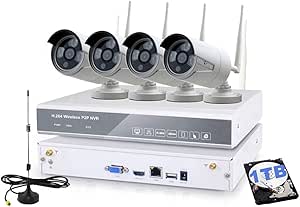A Beginner’s Guide to CCTV Systems and Surveillance
CCTV (Closed-Circuit Television) systems play a crucial role in security and surveillance. Whether for public safety, business monitoring, or home security, understanding how these systems work is essential. In this post, we’ll explore the basics of CCTV systems, their components, and how they are operated.

Understanding a Basic CCTV System
A CCTV system consists of multiple cameras that monitor an area for security purposes. In a basic setup, you’ll find:
- Two Pan-Tilt-Zoom (PTZ) Cameras – These cameras can be moved in multiple directions and zoom in/out using a controller.
- One Static Camera – A fixed camera that cannot be moved or adjusted.
This setup is commonly used in CCTV training courses to help operators understand the fundamental principles of surveillance.
Hand Controller (Joystick) for PTZ Cameras
A hand controller (joystick) allows operators to manipulate PTZ cameras efficiently. It enables:
- Panning (moving left and right)
- Tilting (moving up and down)
- Zooming (twisting the grip to zoom in or out)
Different versions of controllers exist, but they all provide similar functionality for controlling camera movement.
Managing CCTV Feeds with the Overview Screen
- CCTV systems display camera feeds on multiple monitors.
- Large control rooms may have 300+ cameras, while a basic training setup uses only a few.
- The overview screen acts as a monitor bank, displaying all connected cameras.
- Operators can select cameras for full-screen viewing (spot view).
Static Camera vs. PTZ Camera
Static Camera:
- Fixed in one position.
- Cannot be adjusted remotely.
- Useful for capturing still images for identification.
- Uses digital zoom, which may result in pixelation.
PTZ Camera:
- Can move in different directions.
- Uses optical zoom, maintaining image quality without pixelation.
- Ideal for tracking individuals and monitoring large areas.
Zooming and Autofocus Function
- Optical Zoom: Adjusts the lens for a clear, high-quality image.
- Digital Zoom: Enlarges the picture, but may reduce quality and add pixelation.
- The autofocus function helps the camera adjust focus automatically, improving clarity.
If a camera struggles to focus, slightly adjusting the zoom can help regain focus for better image quality.
How CCTV Operators Use Surveillance Systems
Monitoring and Spotting Suspicious Activity
- Operators monitor screens for unusual or suspicious behavior.
- When something suspicious is detected, they zoom in on the subject for closer examination.
Justifying Surveillance Actions
- Operators must log their actions when zooming in on individuals.
- Surveillance actions are monitored and audited, especially in large companies or government-controlled CCTV systems.
- Monthly audits ensure that CCTV usage complies with privacy laws and ethical guidelines.
Returning to Multi-Screen View
- After zooming in, operators can return to multi-screen mode to monitor multiple areas simultaneously.
- This ensures continued surveillance without missing important events.
Legal and Ethical Considerations in CCTV Surveillance
- Privacy Laws: CCTV must be used legally and ethically.
- Compliance & Audits: Many companies conduct monthly audits to prevent misuse of surveillance.
- Action Logging: Operators must document all surveillance actions to justify their monitoring decisions.
Training & Licensing for CCTV Operators
- To work in CCTV surveillance, individuals must complete basic training.
- Many employers require an SIA (Security Industry Authority) license.
- Training covers essential topics, including:
- Camera operation
- Legal responsibilities
- Ethical surveillance practices
- Justification for monitoring actions
Conclusion
CCTV systems are a vital part of modern security infrastructure, helping businesses and authorities maintain safety and order. Whether you’re considering a career in CCTV operation or simply want to understand how these systems work, this guide provides a great starting point.
Are you interested in CCTV training? Let us know in the comments!
